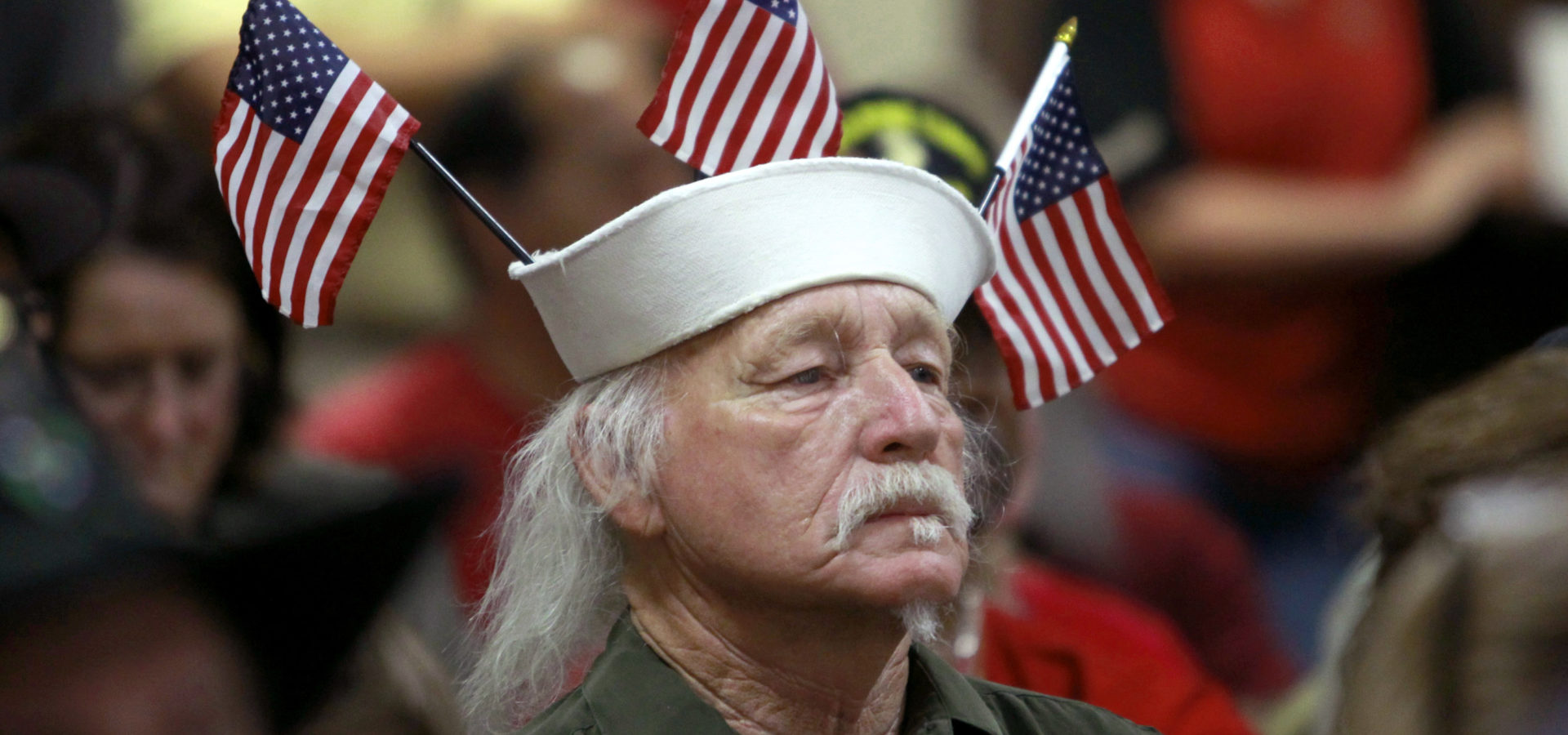
Approximately 1 in every 15 Americans is a veteran, according to the U.S. Department of Veterans Affairs. For most of the 22 million Americans who have sacrificed their health and livelihoods in defense of the nation, the Veterans Health Administration and the Veterans Benefits Administration are critical lifelines. For a large number of veterans, however, prolonged war and austerity politics have created a situation in which delayed or denied care has become a constant reality.
On Wednesday, FBI Director James Comey told a House hearing that the FBI’s Phoenix office has joined the Department of Veterans Affairs’ inspector general in conducting a probe into the actions of the Phoenix Veterans Affairs Health Care System. In April, CNN broke the story of a secret waiting list with the hospital system, in which 1,400 to 1,600 veterans were forced to wait for months to see a doctor. This waiting list was hidden from the official waiting list, and the secret waiting times were not calculated in the reported waiting times for the hospitals. According to internal documents obtained by CNN, this practice was acknowledged and defended by the Phoenix VA’s senior management.
It is estimated that this delay in care led to at least 40 deaths. According to VA rules, a patient is to receive timely care — typically, within 14 to 30 days of the request, with 14 being the maximum for a first appointment. What happened in Phoenix is that the health system created a secondary list without saving appointment requests to the VA computer system. Once the wait time for an appointment was less than 14 days, the appointment was re-entered into the official system, giving the appearance that the request for care was freshly made. However, someone on the secret list could have waited as long as 21 months for an appointment.
This problem was not unique to Arizona, however. Across the nation, whistleblowers have come forward to speak out about the lack of care being offered, extensive wait times and threats of reprisal in order to keep everything under wraps. The U.S. Office of Special Counsel reported that it is actively investigating alleged reprisal threats against 37 VA employees in 19 states, while CNN has reported receiving calls challenging its, reporting and the trustworthiness of the whistleblowers.
“It’s very sad, because people died,” Dr. Stephen Lloyd, a private physician specializing in colonoscopies in Columbia, South Carolina, told CNN.
Lloyd was among the first doctors to speak out against the problems in the VA.
“(Veterans) paid the ultimate price. People that had appointments had their appointments canceled and rescheduled much later. … In some cases, that made an impact where they went into a later stage (of illness) and therefore lost the battle to live.”
An unreported crisis
According to a May 12 to June 3 VA Access Audit by the Veterans Health Administration, at least one incident in which an appointment was scheduled for a date other than what a veteran requested occurred in at least 76 percent of all VA facilities. And 70 percent of the facilities were found to have used scheduling schemes other than the Electronic Wait List or the Veterans Health Information Systems and Technology Architecture package. An estimated 57,436 veterans that requested VA appointments hadn’t received one after more than 90 days, while 63,869 veterans who requested medical appointments over the last 10 years never received one.
At 145 days, the average wait time in Honolulu is the highest in the nation, The Associated Press reported. In Harlingen, Texas, it’s 85 days. It’s 83 in Fayetteville, North Carolina, 81 in Baltimore, and 80 in Portland, Oregon.
While there is currently a nationwide doctor shortage affecting all of the country’s health systems, these extraordinary waits can best be explained as the unintended result of 11 years of war without adequate consideration on how best to deal with the large influx of wartime soldiers — who have needs that require attention when they return home. While the VA system was adequate for the needs of the veterans of World War II and the Korean, Vietnam and First Iraqi Wars, the more than 2.5 million military personnel deployed to Iraq or Afghanistan since 2001 represented a clear need to expand the VA system’s capability to address the heightened need for assistance.
“When I say 2.5 million people have served in Iraq and Afghanistan, jaws drop,” said Paul Rieckhoff, CEO of the advocacy group Iraq and Afghanistan Veterans of America, to McClatchy DC. “I know which lines are going to get gasps, and that’s one of them. I don’t think they appreciate how many people have served, and particularly the number who have had repeated deployments. You’ve had an unprecedented demand on a small population. The general public has been incredibly isolated from those who served.”
However, not everyone agrees that the problems with the VA started with the decision to go to war again in the Middle East.
“The VA has received plenty of additional funding to take care of the veterans from Iraq and Afghanistan. So the problems were not caused by lack of money,” Howard Prince II, a fellow at the University of Texas at Austin’s Center for Politics and Governance and a clinical professor, told MintPress News.
“Resources have gone up at a higher rate than the number of veterans over the past decade. The more important factors are that it is a large bureaucracy that is hard to hold accountable, the metrics in use recently — such as the 14-day wait criterion — are unrealistic and are inappropriately tied to bonuses for managers and executives. There is no competition, so the bureaucracy moves at its own pace,” explained Prince, who is also a retired Army brigadier general, familiar with the VA system as both a patient and a military medicine expert.
A political tornado
The political response to this revelation has been deafening. Political pressure forced Eric Shinseki to resign as VA secretary on May 30. (Shinseki was previously removed as Army Chief of Staff over his criticism of the George W. Bush administration’s underestimation of the troop requirements for the Iraqi invasion.)
Meanwhile, the Senate and the House have passed bills blocking at least some of the VA’s employee and executive bonuses and clearing the way for VA executives to be investigated and fired. Additionally, legislation is being debated to allow the VA to offer Purchased Care — or non-VA health care paid by the VA — in order to clear the backlog.
It is not exactly clear how this situation will play out once the media attention dies down. Since 2005, the congressional Republicans have blocked increases in the VA budget that would have paid for infrastructure improvements and expansions. Worse, Rep. Paul Ryan’s 2012 proposed budget would have actually taken $2 billion from the VA, which would have caused the VA to close facilities in lesser-served rural areas.
Yet, it has been alleged that the issues with the VA are as much a local problem as a Washington problem. “At the very core, there is a lack of accountability with the VA throughout the system,” Art Terrazas, director of government affairs for the American Counseling Association, told MintPress News.
The association has been on a multi-year campaign toward trying to increase the number of psychiatric counselors employed by the VA. “What we are talking about is career leadership in the VA at the local and regional level not being held responsible for many years and knowing that they will not be held responsible.”
Local authority and empowering Congress
Terrazas has indicated that while budgetary considerations are made in Washington, hiring and resources allocation are done on the local level with minimal departmental or congressional oversight. So, if a local VA medical center director feels that his center does not need additional physicians or counselors, he is free to make that determination — even if there is a backlog suggesting that additional assistance is needed. Worse, the director may be unaware that he has the authority to hire without approval from Washington. While initially allowing medical directors the freedom to make decisions that best serve the needs of the local community, this sense of local authority has become an immediate obstacle to system-wide reform.
The situation is further complicated by the fact that no one is exactly sure of the consequences of “business as usual.” To date, there has been no study or review comparing the health and livelihood of the veteran’s community to that of the general public. While it is clear that veterans are not receiving immediate care, it is not as clear what the long-term implications of this may be, which undermines calls for proactive remedies to the situation and refutes attempts to make cost-efficiency analyses for care offered and needed.
It may be that the VA system must be reformed. Suggestions — such as turning the VA into a single-payer health insurance provider for veterans that do not have local access to VA facilities or cannot receive immediate benefits — will be entertained in coming weeks and months, but ultimately, the VA’s future lies with Congress. Beyond legislative and financial controls, Congress can enforce its oversight authority to force compliance with the best interests of the veteran community.
“This presidency will eventually end. A new administration will take its place,” Terrazas said. “It’s Congress’ job to remind these administrators that they cannot wait out the clock anymore.”
“I am skeptical that a large government bureaucracy can reform itself and be managed effectively from a central headquarters in Washington,” countered Prince. “I think government is simply incapable of overcoming inherent organizational pathologies in such bureaucratic systems.”
He suggested that it’s “time to abolish the entire VA health care system” and create a system in which eligible veterans could use vouchers for health care in private hospitals and clinics, as the GI Bill has already done for education benefits.
“This concept is not likely to be embraced simply because it would work against the entrenched interests such as a unionized VA workforce, government inertia, politicians wanting to bring home the pork in the form of new and bigger VA clinics for their districts and others. So we are likely to see some short-term attempts at fixes, such as the most recent legislation from the Senate — led by Senators McCain and Sanders — but real lasting reforms are not likely soon.”
Those charged with overseeing veteran care on the state and local levels are also responsible for speaking up and forcing ownership of the state of the VA. While it can be argued that the Phoenix case was exceptionally grievous, it can also be argued that it wasn’t inconspicuous — Phoenix has a Military Veterans Commission, which advises the city council on “all matters pertaining to the affairs of military veterans residing within the City of Phoenix.”
So, why didn’t the commission notice anything?
“We see people waiting for help,” Terrazas explained. “This will have an effect on their health — not only their physical health, but their mental health, as well. There is a 2012 inspector general report that showed that the wait times that the VA was reporting was not reliable, and so that will have an effect on those trying to get in for depression or for substance abuse.”
He shared the story of a veteran from El Paso, Texas, who was seeking help through the VA system, but “couldn’t get in … and ultimately took his own life.”
“By the VA’s own standards, 18 to 25 veterans are lost to suicide everyday. How many of these veterans did not receive the care they needed? How many of these deaths could be avoided?”


